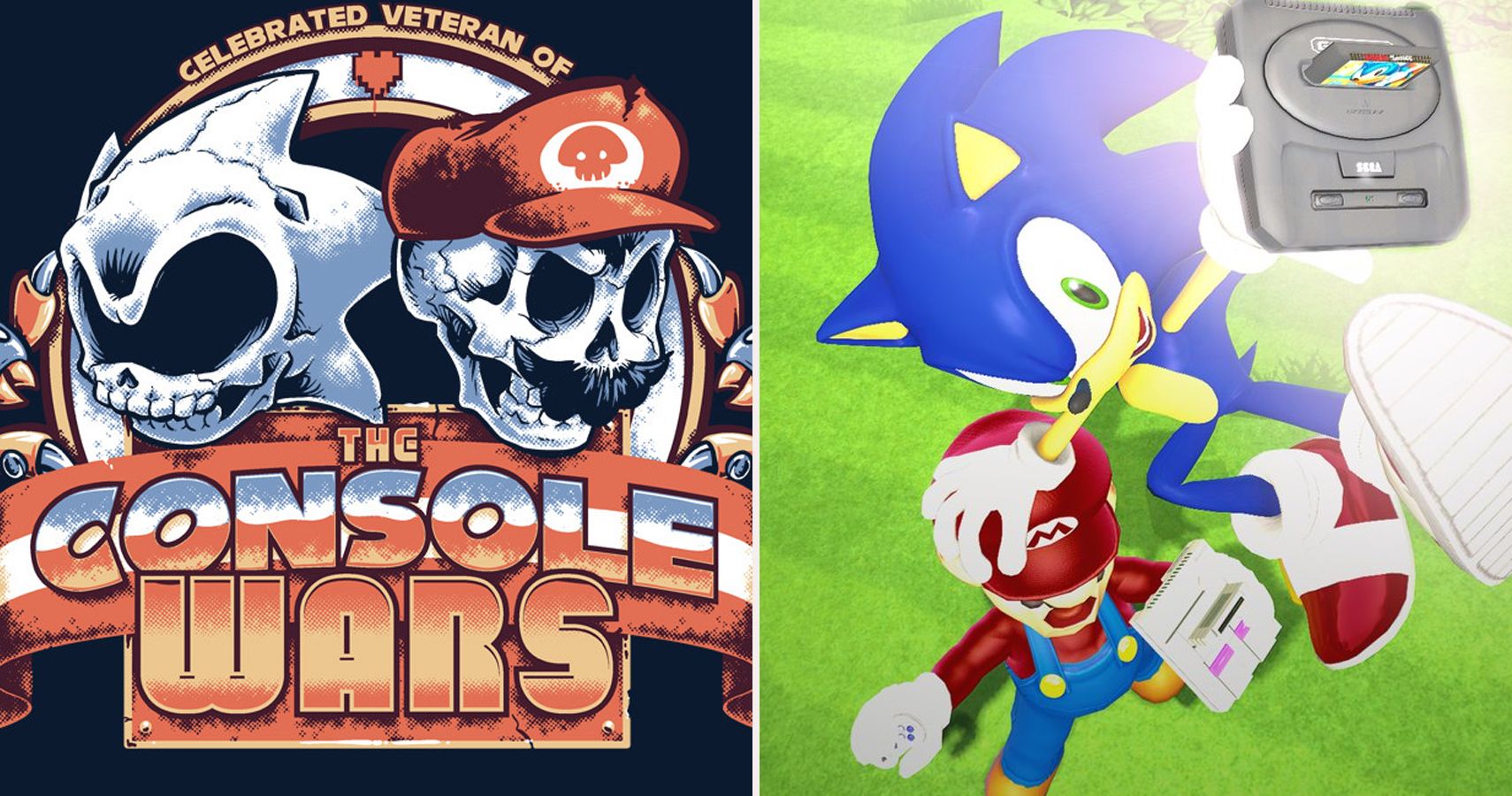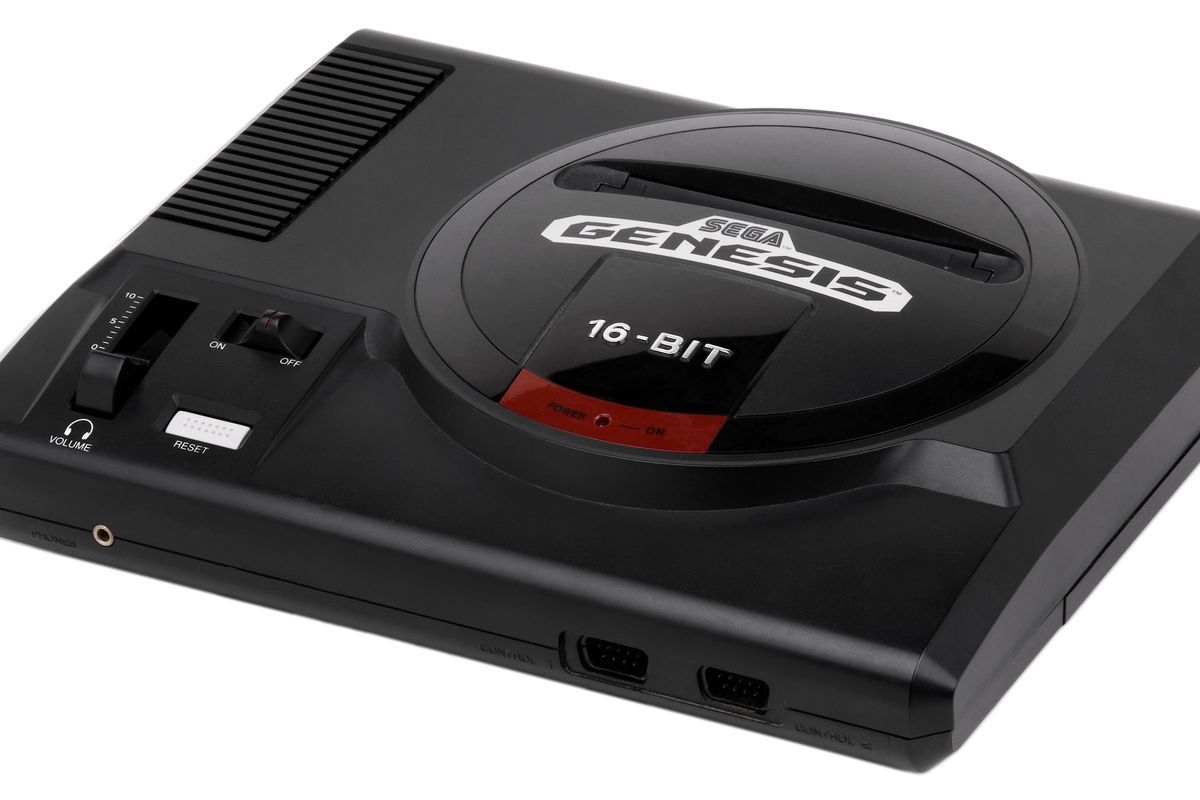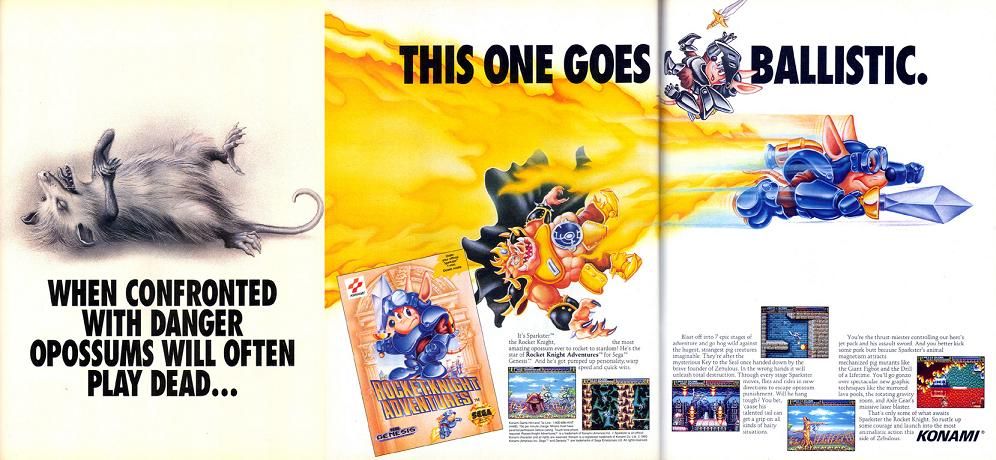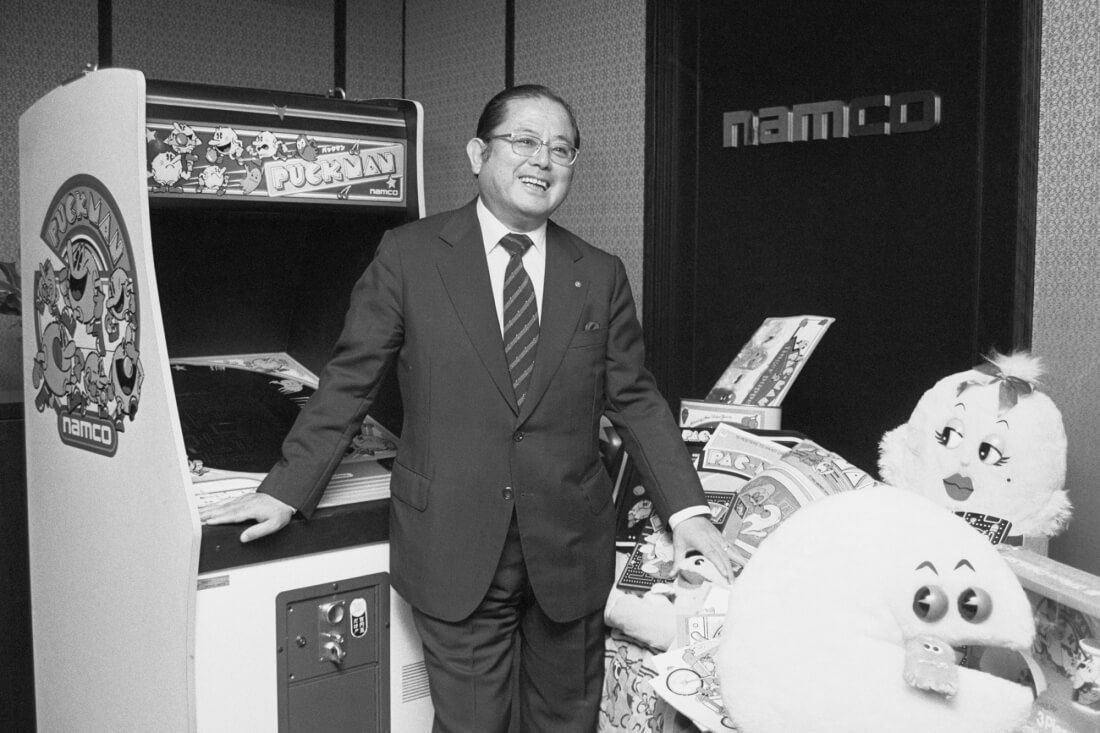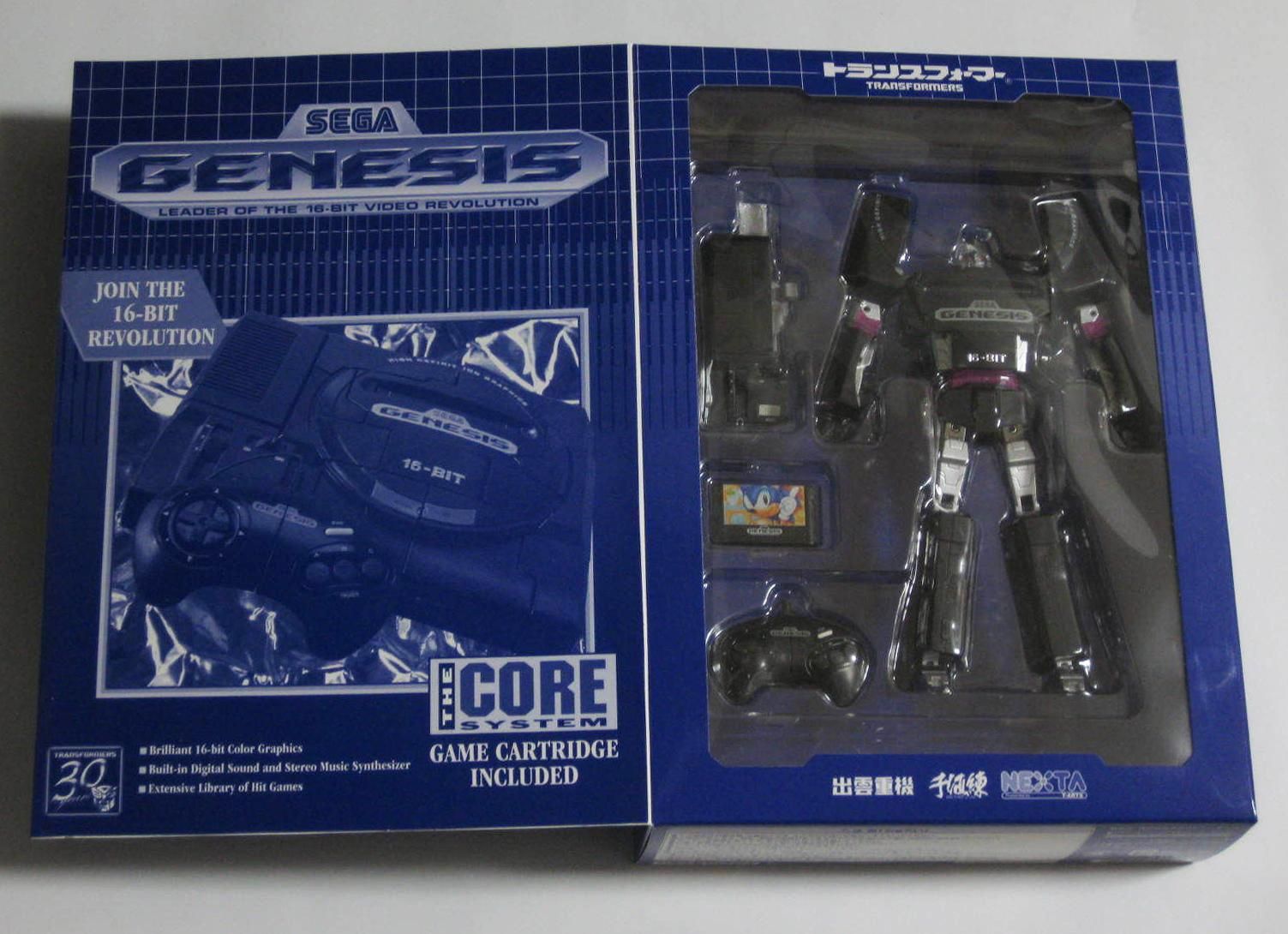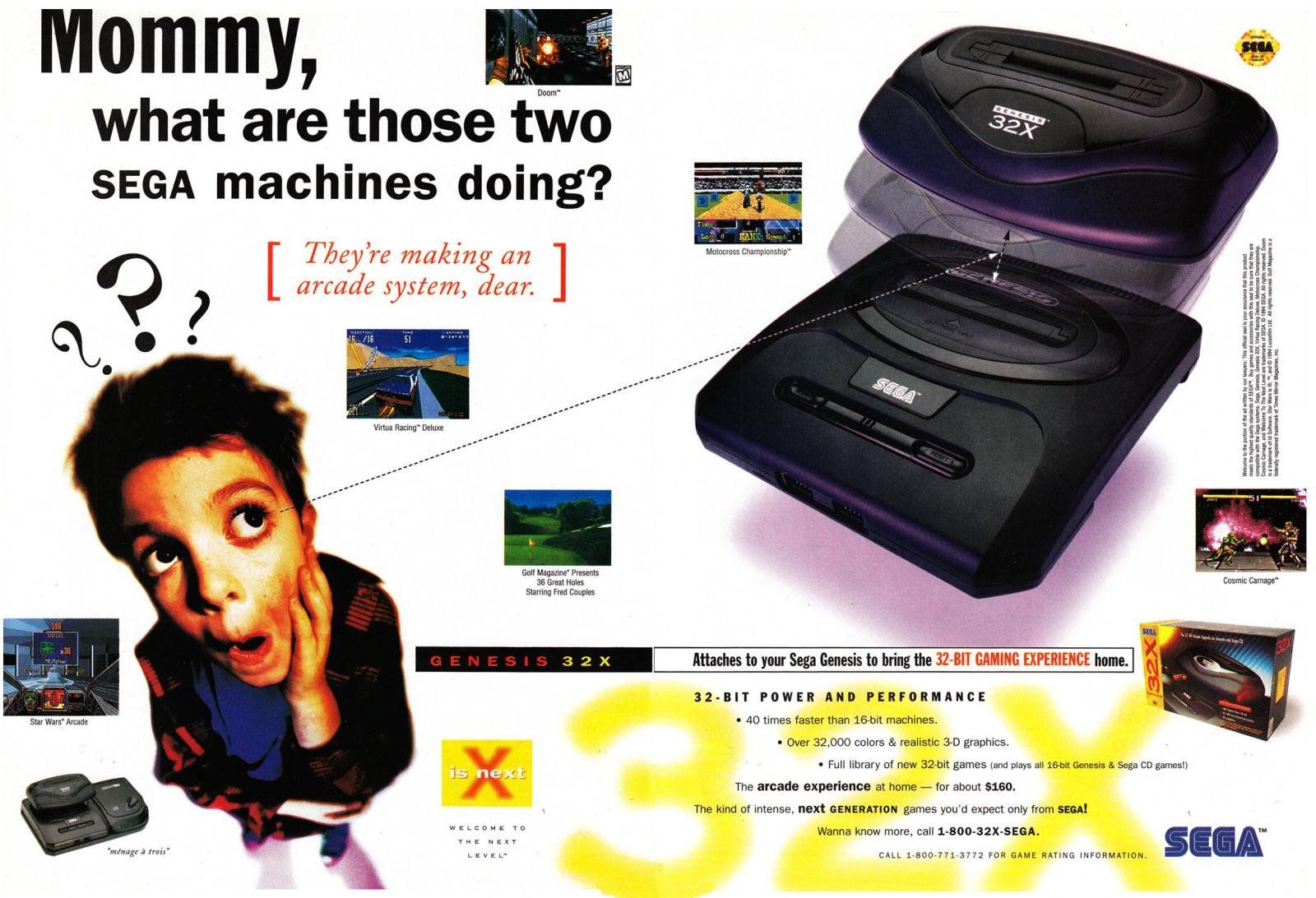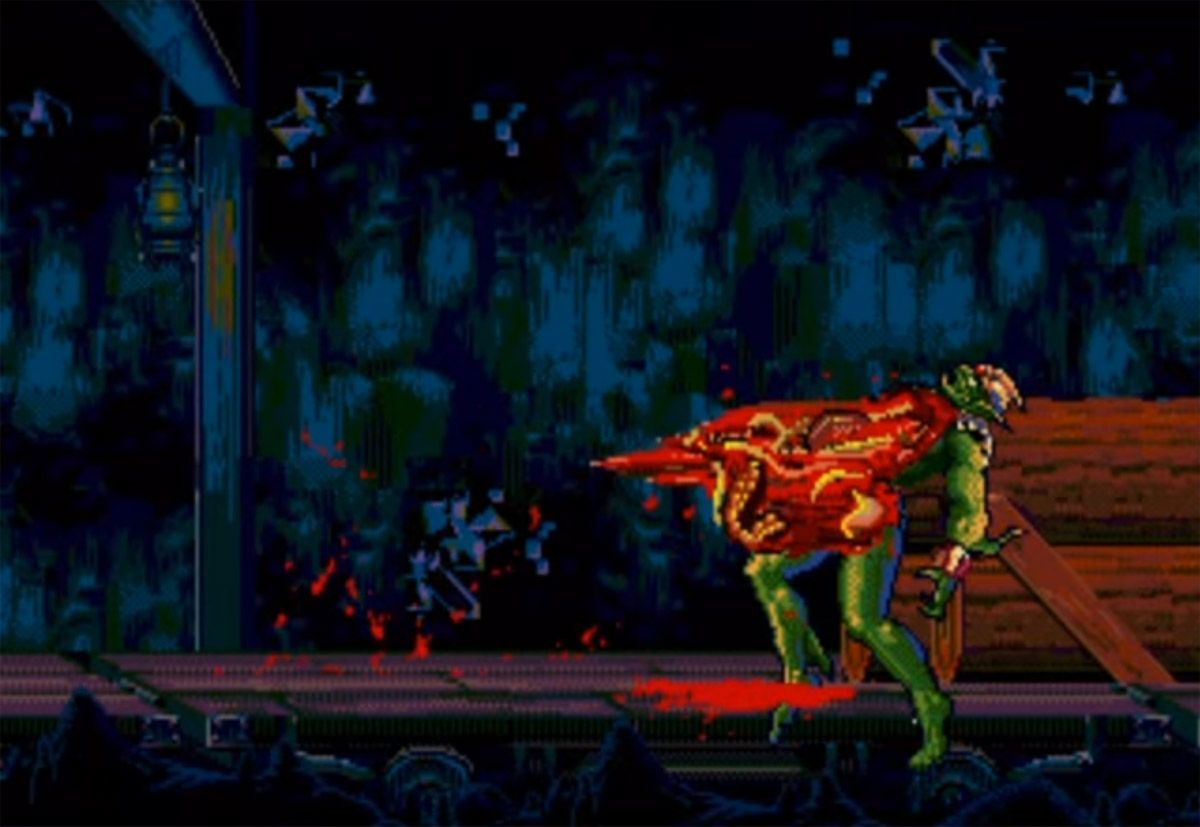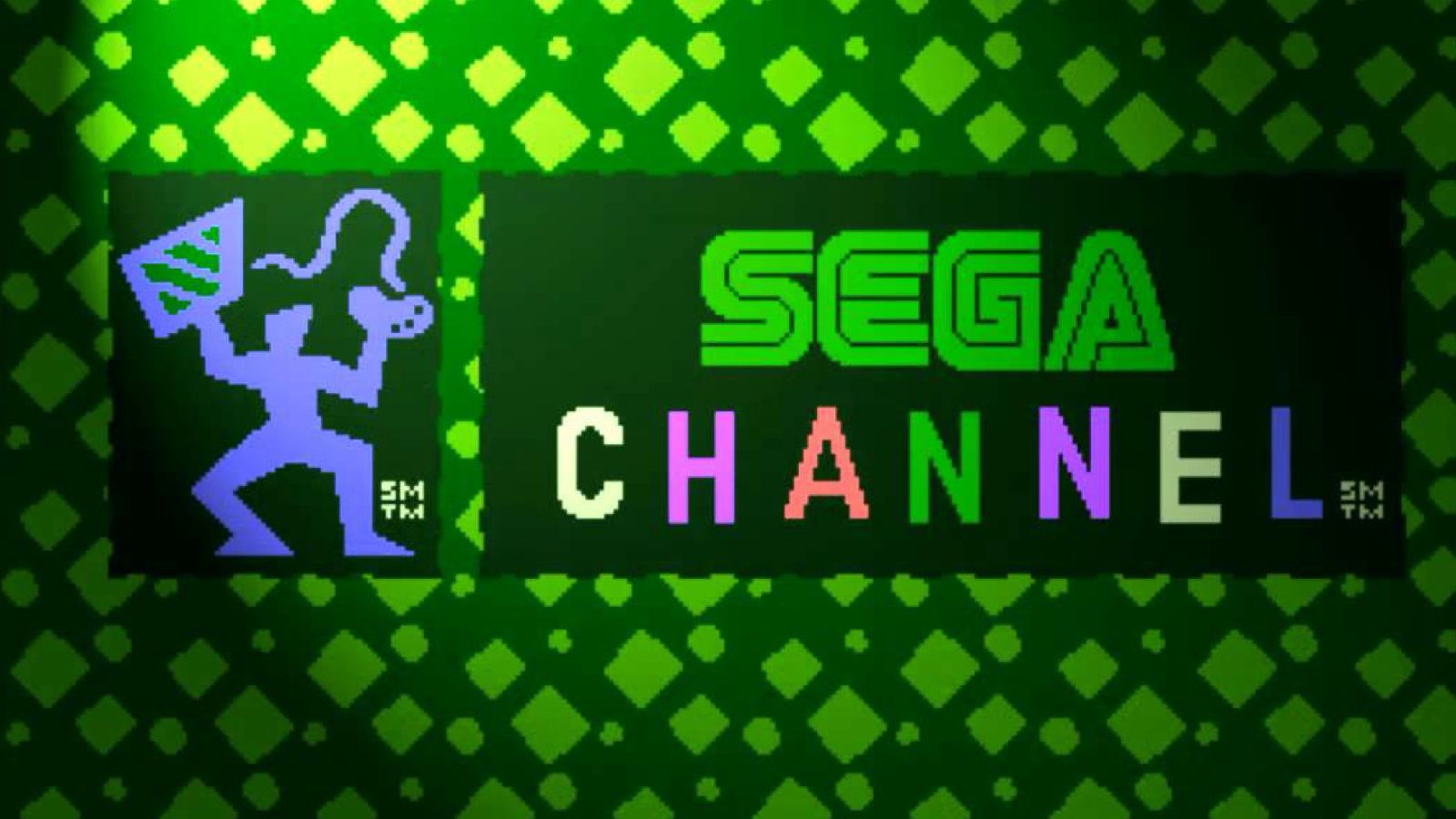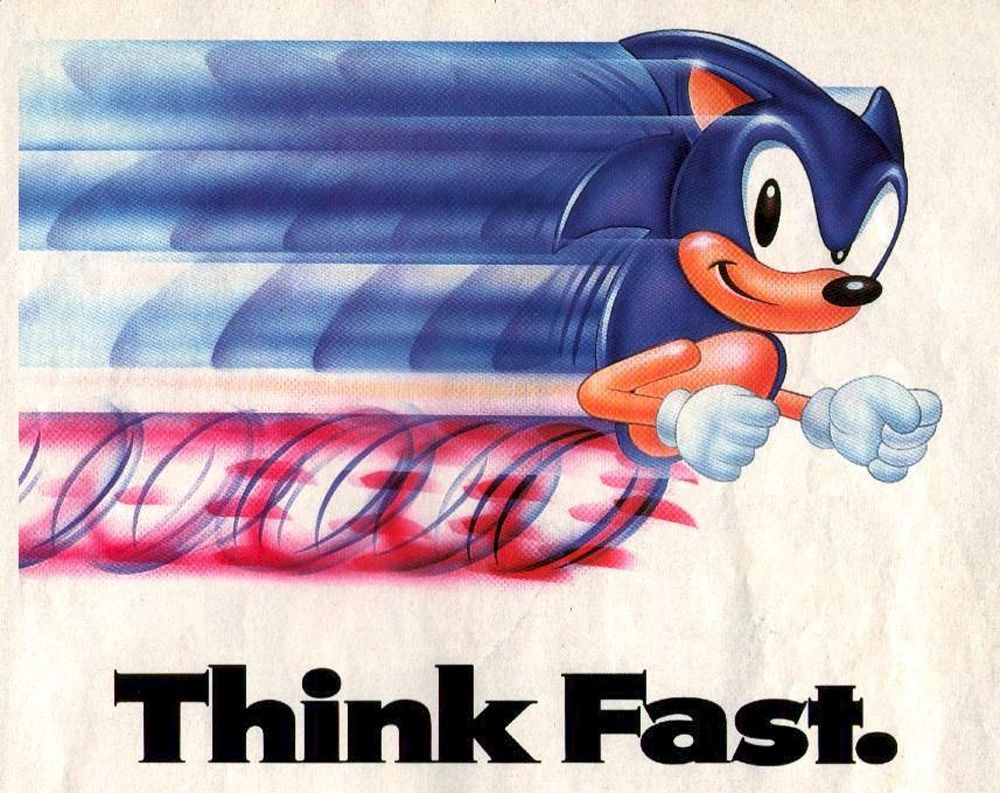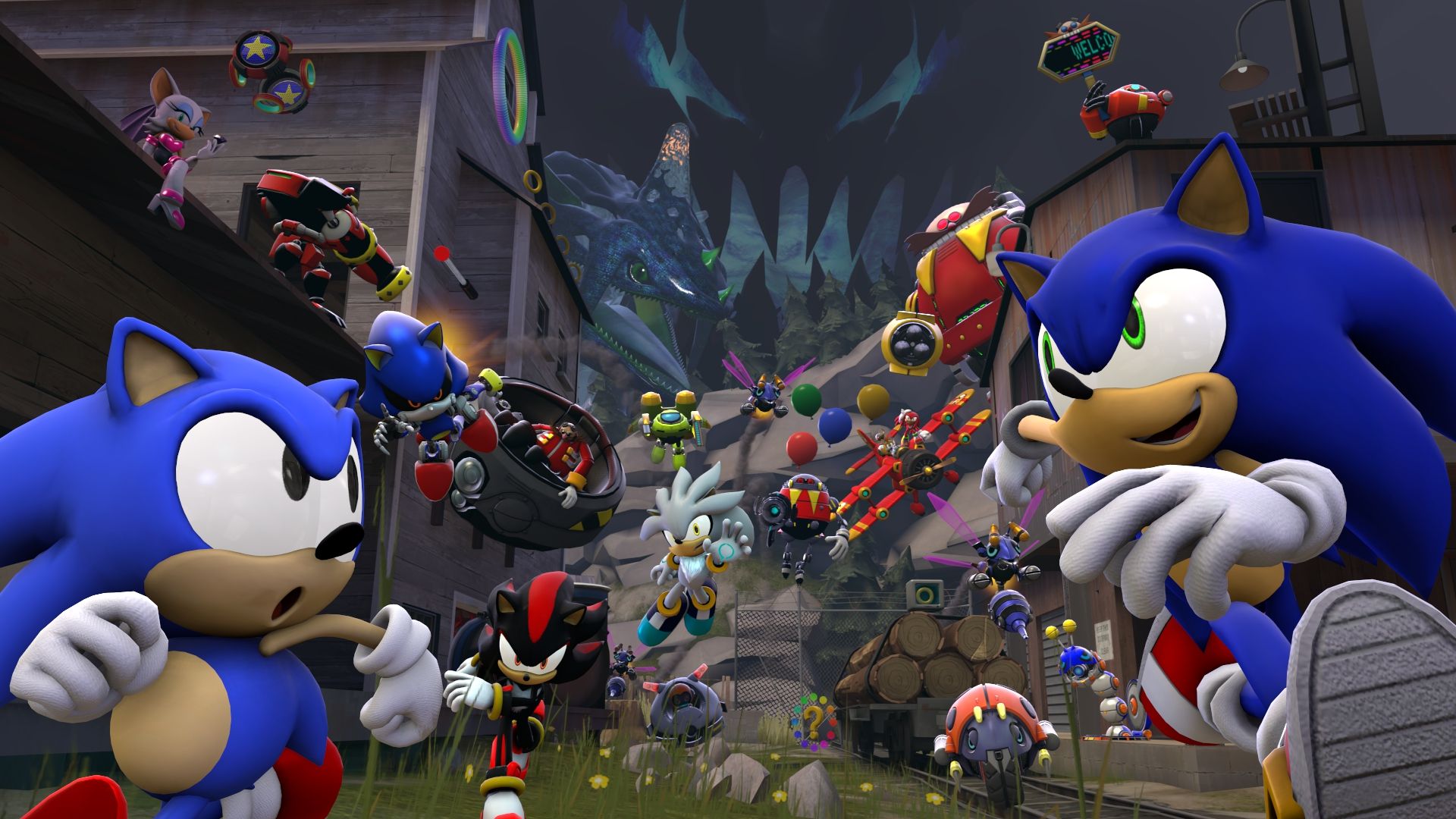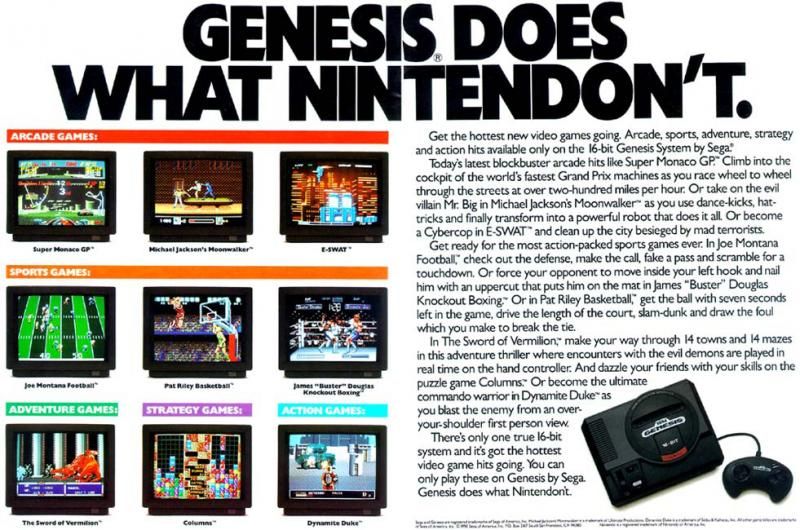The age-old question of the nineties child: Genesis or SNES? Long before internet geeks flamed each other on forums and Reddit threads about specs and performance of the next-generation consoles, Nintendo and Sega were embroiled in the inaugural console wars. For Sega, taking down Nintendo, who were dominating the home gaming market for an entire decade, wasn’t going to be a cakewalk, but more of a food fight that featured numerous smear campaigns and dirty tricks. It called for creative advertising campaigns attacking the prudish and tame nature of the gray brick known as the Super Nintendo.
One point Sega wanted to present time and time again to the consumers was that the SNES was geared for family fun, and the Genesis was for hip and serious gamers. If you were a preteen or teen, the Genesis was the clear choice for the cool kids. So influential was this competition that years later, the internet geeks of the dial-up generation are still debating the 16-bit wars. Though they eventually lost the war, Sega did do a lot of things right.
Here are 15 reasons the Sega Genesis is still better than the Super Nintendo.
15 SEGA! Hear It. Yell It. Love It.
There is nothing more exciting for a preteen than to go to his friend’s house and load a Genesis cartridge to have the SEGA logo pop up with that unmistakable vocalization of “SEGA!” It was even more exciting to notice which games had a gag with the SEGA intro logo. Everyone got in on the act: Sonic the Hedgehog, Genie from Aladdin, Doraemon, Earthworm Jim, Boogerman, Sylvester and Tweety, Cool Spot, and Vectorman all interacted with the SEGA logo. The Sega sound clip evolved over time, as the company, and the advertising campaigns did. Sega had one final stroke of brilliance in its long history of marketing gems with the Genesis. For the duration of the Genesis’s production, the Sega Scream became as iconic as Sonic itself. Nothing was more memorable and catered to the rebellious nature of the console than watching one of their many TV spots with an intense screaming of “SEGA!” to close out their commercials.
14 Black Is Sexy
Though I lack the concrete evidence to prove that black is the sexiest color of them all, I am quite positive there is something about an object being black that makes it intrinsically sexy and cool. The Little Black Dress. The New Black. These are all phrases that call to the special nature of the color black. Guess what? The Sega Genesis was indeed black. Compared to the taupe-like gray and boxy, utilitarian structures from Nintendo, the Genesis was jet black and had rounded areas to accent its rectangular exoskeleton. If there are two things that scream boring, it is gray and boxy. Nobody takes their gray box of a car for a drive along the coast and enjoys it. You jump into a shiny black coupe with sexy curves and give it the beans.
13 Excellent Console Exclusives
During the first console wars, exclusive titles and franchises defined what a system was and what fanbase it can attract. The term “killer app” referred to a game so influential that people often purchased the console just to play it (i.e. Space Invaders for the Atari 2600). Every exclusive series that Nintendo had, Sega duplicated it for the Genesis. SNES had Final Fantasy and Chrono Trigger, so Genesis had Phantasy Star and Shining Force. SNES had Mario and Donkey Kong Country. Genesis had Sonic and Vectorman. Their other exclusives featured the who’s who of 16-bit gaming: Rocket Knight Adventures, Streets of Rage, Shinobi, Toejam and Earl, Ecco the Dolphin, Columns, Strider, Gunstar Heroes, Michael Jackson’s Moonwalker, Golden Axe, Altered Beast, and I can keep going.
12 Supply And Demand: Sega Genesis Plug And Play Is Available
Nintendo has strange justifications for their marketing and business practices. Earlier this year, they announced that they would end the production of the NES Classic Edition despite selling over 2 million units and market demand for more. As someone who never even came close to attaining one, hearing this news created an incredibly sour taste in my mouth, and I’m not the only one who is furious with their decision. Killing the system right now just screwed over consumers who were hoping to purchase one for MSRP. That being said, the Sega Genesis classic is being manufactured by AtGames. While the reception of the system is extremely mixed due to suspect quality, it does make the Genesis available for nostalgia-hungry consumers at a fair price. With the NES Classic fiasco, the dread for the upcoming SNES Classic is already quite palpable. It’s like the Amiibo-hunting nightmares all over again.
11 Nintendo's Draconian Contracts And Restrictions On Third Parties
Nintendo did not make it easy for third-party companies, due to the strict rules they presented in their contract agreements. For the duration of the company’s first two home consoles, Nintendo placed quotas on how many games each third-party could release any given year, what kind of censorship each title went through, and even preventing them from doing business with competitors, NEC and Sega. At the end of the day, Nintendo controlled all production of gaming cartridges. While Sega did strictly control cartridge manufacturing for the Genesis, the were more than open to various types of games than Nintendo. Namco founder Masaya Nakamura spoke out against Nintendo’s monopolistic practices. Despite a great relationship between the two companies (40% of the third-parties sales were on NES), Namco didn’t receive any preferential treatment. Thus, Namco ended up making nearly twice as many games for the Genesis than for the SNES, including the Pac-Man and Splatterhouse series.
10 Megatron, The Sega Genesis Transformer
Transformers is one of the most lucrative and influential franchises in the world with tons of collaborations, sponsorships, and tie-in. As a Transformers collector, I have seen them all: Pepsi Prime, Swerve the Chevrolet Aveo, and a Hello Kitty that transforms into a semi-truck. You know what I have never seen? A Super Nintendo Transformer. But do you know what I have in my display case? A rare Sega Genesis that transforms into the most badass villain this side of Junkion. His name is Megatron. This a robot that shot Ironhide in the face and killed Optimus Prime twice in the original cartoon. If this doesn’t contribute to the radical and bad-boy image of the Sega Genesis, what will? It’s cool to be bad. By the way, his rival is a Playstation Optimus Prime. Sorry, Nintendo.
9 It’s Cool To Be Bad
What do I mean by cooler? For a preteen, whatever your parents restricted your access to was instantly cool. This meant no Mortal Kombat, no Sports Illustrated Swimsuit Issue, and no Beavis and Butthead. The Genesis’s advertising campaigns and bad-boy persona didn’t make it very attractive to parents and relatives. I remember my aunt telling me she had gifted me a Super NES for Christmas because the Sega one seemed too adult for me. Though I loved my SNES, the Genesis became my forbidden fruit. Going to a friend’s house to play proper Mortal Kombat on the Genesis became a naughty and rebellious activity. Even Sonic had a raised eyebrow and smirk, meaning he was up to no good. Because of this, the Genesis is cool. For more proof, reread the first previous reasons over again.
8 Better Port, Better Version
This one might cause some backlash. What should be considered a better game? Better gameplay, graphics, or sounds? For me, when it feels right and fun, that is what constitutes better. I think there is some 'je ne sais quoi' about the Genesis version or most third-party games. Sure, there are times when Genesis just stinks up their ports and versions of games, such as was the case with Primal Rage. Yet, the Genesis incarnations of Madden 93 and Aladdin just take the proverbial cake. Knowing how the folks at Sega are, they would gladly take the cake, smash it in Nintendo’s face, and scream an endless stream of catchphrases like the Rock did on a classic episode of Raw is War. Genesis gave us the first chance to play as Balrog, Vega, Sagat, and M. Bison in the comfort of our own home. Also, they threw in that “controversial” fight in the intro and decided not to censor the blood and win quotes. Then, there was Mortal Kombat. I knew of many disappointed gamers who purchased the SNES version only to find out the blood was omitted and the fatalities changed. The Genesis kids lucked out, once again. Robocop vs. Terminator just seemed better on the Genesis.
7 Pure, Unadulterated Violence
Genesis had a litany games to whet the appetite of those looking for violence and gore. Titles such as Splatterhouse and Eternal Champions were classics that featured great gameplay with some gruesome deaths sprinkled in. Some might say the SNES had Killer Instinct, but I look to that as more of an outlier. Bar none, Genesis maintained a more blood-friendly approach. While Nintendo took the stance of family friendly and went to great lengths to censor violent titles on their Super Nintendo, Sega disregarded that notion and allowed the inclusions of blood and violence to remain on the Genesis versions. One of the most widely-known of these instances was the port of Mortal Kombat to the home consoles. Nintendo censored out the blood by recoloring it as sweat and removing several notable fatalities. Genesis, on the other hand, allowed players to input a Blood Code to unlock these features rather than removing them completely, which satisfied gamers, as well as conscientious parents. Blood was also removed from the SNES versions of Street Fighter II, Robocop vs. Terminator, and Zombie Ate My Neighbors, while shown in their full glory on their Genesis counterparts. Bottom line: Genesis does violence. Nintendon’t.
6 Innovation Of The Sega Channel
Have you ever accessed DLCs or downloaded demos for upcoming games through PSN or Xbox Live? For most people with modern consoles, the answer is yes. Being connected online is so essential now that there are modes and features designed just for being on the internet. Sega did the same thing for the Genesis nearly two decades ago. The Sega Channel was a subscription service that utilized cable television to deliver content to consumers without them leaving their homes. The channel allowed gamers to download demos and full games through a coaxial cable connection, which was different than the internet as it only allowed downstream. Though innovative, the service was pricey and failed to gain long-term traction. Add in Sega CD and the 32X, the Sega Channel was one of the forward-thinking gambles that contributed to the demise of Sega in the console market, but its legacy cannot be more important to modern gaming.
5 More Sports games
Calling back to their Nintendon’t ad campaign, Sega was serious about their sports simulations being their advantage over rival Nintendo. By signing three of the most successful sports figures of the eighties, Montana, Douglas, and Riley gave the company star power and championship pedigree. During the decade, Montana won three Super Bowl rings, Riley lead the Lakers to four titles, and Douglas slayed Mr. Punchout! Mike Tyson to become the undisputed heavyweight champion. Genesis would boast some of the best retro sports games of all time: Super Monaco GP, the first and second Madden titles, NHL ’94, and those wonderful Mutant League gems. I’ve heard of people purchasing Genesis just to play Madden. How crazy is that?
4 Blast Processing
Sega was so great with marketing the Genesis that their campaigns and slogans are showing up on this list multiple times. Utilizing the sheer game speed of Sonic the Hedgehog 2 as the basis of their marketing, the Blast Processing campaign sought to exhibit the Genesis’s technical superiority over its competitor. Until this day, I am not sure what “Blast” really meant, and when I ask my enlightened friends, they don’t really know either. Often the focus of attacks in ads, Nintendo never seemed to lower itself to the level of their competition, but Sega’s marketing was so successful it garnered a response from their rivals in 1994, nearly two years after the fact. Uncharacteristically, Nintendo bought ad space in prominent gaming magazines like EGM and GamePro and went onto a mud pile and began slinging like they never did before, calling Blast Processing a myth and presenting inaccurate information about the Genesis’s performance. Nothing is like making your upstanding rival so desperate that he/she begins to cheat and fight dirty as a last resort. Bravo, Sega.
3 The Controller Was Better
While this is totally subjective, the Genesis controller was just plain better than the Super Nintendo one, and this is coming from someone who only had a Super NES growing up. My only interaction with the Genesis controller was at the electronics section whenever my father took me to Toys “R” Us, Kmart, or Target. What always surprised me about the controller was that though it appeared bigger, it was light as a feather. It felt ergonomically correct, and the buttons were set up just like an arcade cabinet for fighting games. That was cool! Playing Street Fighter II and hitting those L&R shoulder button on the SNES controller never felt quite right, almost like a bastardization of any arcade port. As soon as Sega went from the three to six buttons, it was game over for the competition. Even today, no other stock console controller can hold a candle to the brilliance of the Genesis controller. The Playstation ones are too stiff, the Xbox ones are too clunky, and Nintendo never seems to get it right.
2 Sonic The Hedgehog
Deeming Alex Kidd as an unsuccessful company mascot, Sega’s in-house studio, AM8, would be tasked to create an iconic character capable of competing with Nintendo’s portly, Italian plumber not only as a logo, but as the title character of his own successful video game. It is no wonder the codename of this project was “Beat Mario.” In mid-1991, Sonic the Hedgehog would arrive in the nick of time to act as the face of Sega against the impending juggernaut soon to be known as the Super NES. The gameplay of the first Sonic the Hedgehog game was lightning quick, unlike any platformer preceding it. Gameplay aside, the character of Sonic himself became an instant hit with testers, who overwhelming preferred him to Mario. Sega went all-in with Sonic. It replaced Altered Beast as the pack-in game and allowed early adopters a complimentary copy through the mail. Now that Sega is out of the console-making market, Sonic is still surviving as the smirking face of Sega through merchandising, comic books, and as Mario's Olympic rival. It is amazing how things come full circle.
1 Genesis Does What Nintendon’t
Genesis Does What Nintendon’t. Not just brilliant wordplay, but a slogan that was the definitive rebuttal of the Sega loyalist in any console wars debate. In North America, the Genesis had a two-year grace period before Nintendo would release their successor console to their immensely popular Nintendo Entertainment System. Sonic wasn’t born yet. Without the services of the plucky blue hedgehog, then-president of Sega of America Michael Katz launched the Genesis Does What Nintendon’t ad campaign to capitalize on the company’s effort to differentiate itself from the competitor. Through print and television, Sega ruthlessly attacked Nintendo and gave compelling reasons for people to purchase the Genesis. It was 16-bit, and their dedication to sports simulations was unparalleled with exclusive licenses with Joe Montana, Buster Douglas, and Pat Riley to create games with their likenesses. On top of that, Sega would give you one of these licensed games free with each purchase of a Genesis. Did Nintendo give consumers that? Nintendidn’t! Until this day, it was undoubtedly the single most important shot ever fired in any console war.

